|
A Brief History of Postal Cards in Yellowstone National Park
Page One of Two
Copyright 2014 Robert V. Goss
Please feel free to email me with any questions or comments.

Early History of U. S Postal Cards
President Grant authorized the use of postal cards in 1872, and on May 12th, 1873, the United States Government released the first official postcard in the U.S. The words Postal Card were printed on its back along with a one-cent denomination. However, if there was any handwritten message, the cost doubled to two cents. Only government issued cards were allowed to use the words Postal Card by law. The side with postage was designated exclusively for the address and the other side was for the message. Beginning in 1875 these blank cards were available for purchase in large uncut sheets, and they were acquired by many private firms who could then print advertising messages across their fronts. Postals quickly proved to be successful for they were soon selling at the rate of a million per day. Prior to 1893 these cards were almost always used for advertising with a rare few used as greeting cards. This period from 1873 to1897 is sometimes referred to as the “Pioneer Period.
|
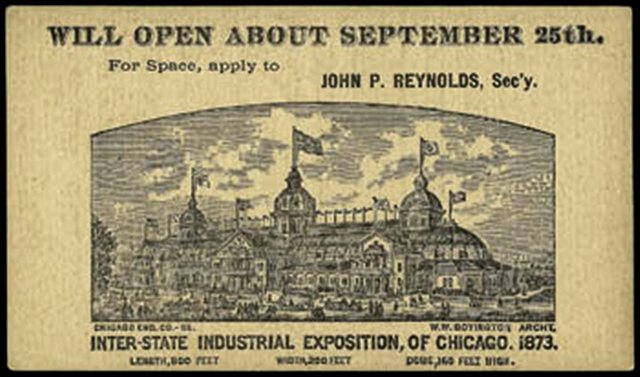 |
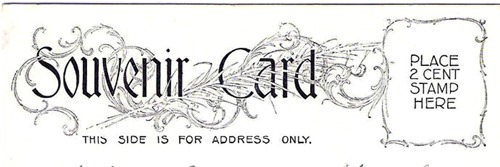 |
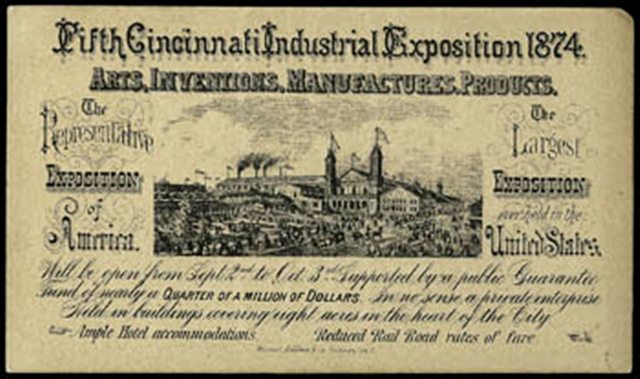 |
| 1873 Inter-State Industrial Exposition |
Souvenir Card Logo - 2 Cents |
1874 Fifth Cinncinati Industrial Exposition |
The first American postcard was developed in 1873 by the Morgan Envelope Factory of Springfield, Massachusetts. This first postcard depicted the Interstate Industrial Exposition that took place in Chicago. Later that year U.S. Post Master John Creswell introduced the first pre-stamped "Postal Cards," often called "penny postcards." Postcards were created because people were looking for an easier way to send quick notes. The earliest know “picture postcards” to be printed as a souvenir in the United States was created in 1893 to advertise the World's Columbian Exposition in Chicago. This was a set of 12 postcards (series No. 1) published by the American Lithographic Company of New York and were the first commercially produced postcards to be sold to the general public at the Fair.
|
|
Left: The Electrical Building at the 1893 Columbian International Exposition. One of a series of 12 postcards. The exposition, also known as the Chicago World's Fair was a 400-year celebration of the discovery of the new world by Columbus in 1492.
Right: The reverse side of this One-Cent Postal Card, which was only for the address. Former President Grant is depicted in the upper right corner.
[Postcard Courtesy Chicago Postcard Museum] |
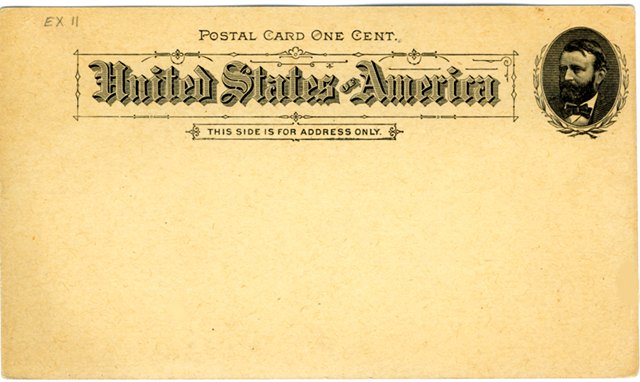 |
|
The Post Office was the only establishment allowed to print postcards, and it held its monopoly until May 19, 1898, when Congress passed the Private Mailing Card Act, which allowed private publishers and printers to produce postcards. Effective on July 1 of that year, the United States government initially prohibited private companies from calling their cards "postcards", so they became known as "souvenir cards." These cards had to be labeled "Private Mailing Cards." The postal rate was one cent and the maximum size was 3-1/2 x 5-1/2”. The prohibition on the use of the word Postcard was rescinded on December 24, 1901 for private companies. They still were not allowed to have a divided back and correspondents could only write on the front of the postcard. This was known as the "undivided back" era of postcards. On March 1, 1907 the Post Office allowed private citizens to write on the address side of a postcard and it was at this time that postcards were allowed to have a "divided back." In these cards the back is divided into two sections, the left section being used for the message and the right for the address. Cards previously printed under the old rules were still able to be used.
|
|
|
The Post Office Department also ended its monopoly on the printing of postals, but the words Private Mailing Card - Authorized by the Act of Congress on May 19th, 1898 were required to be printed on the back of all cards not issued by the government. Regulations also required that these cards be slightly smaller in size at 3 1/4 by 5 1/2 inches and printed in light colors of buff, cream, or gray.
|
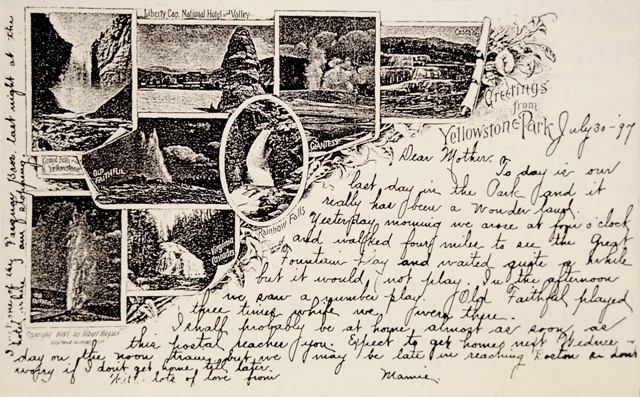
Albert Kayser Mailing Card republished by Edw. H. Mitchell in 1898
as a Private Mailing Card
|
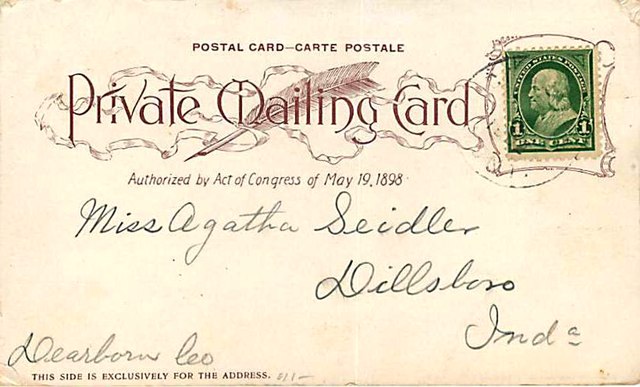
Reverse of 1898 Edw. H. Mitchell Private Mailing Card
|
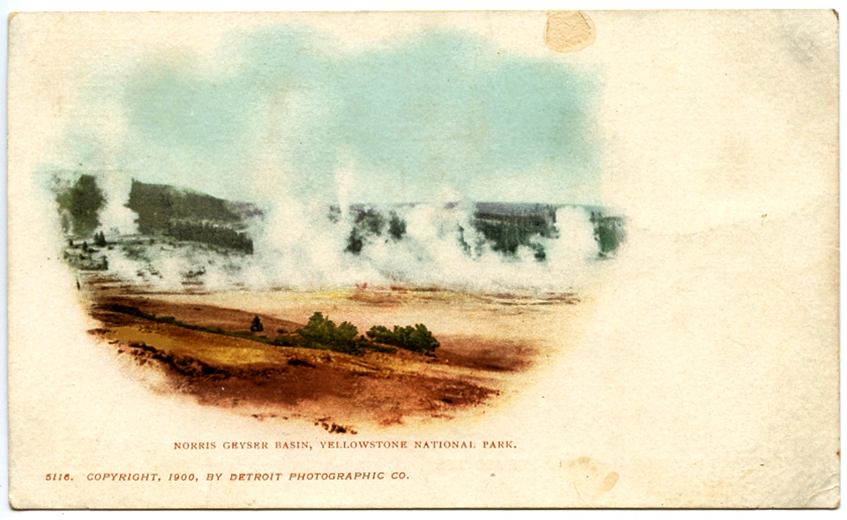
Norris Geyser Basin, Yellowstone National Park
1900 Detroit Photographic Co. Vignette #5116
|

Reverse of 1900 Detroit Photographic Co. Vignette #5116
Private Mailing Card, Authorized by Act of Congress
of May 19, 1898.
|

Norris Geyser Basin, Yellowstone National Park
H.H. Tammen Co., Copyright 1904, Vignette #351
|
Reverse of 1904 H.H. Tammen Co. Card. Now called a Post
Card, the reverse is still intended for address only, despite
the writer's adding a note. Postmarked 1907.
|
|
The Market Expands . . .
Prior to 1909 most Yellowstone PC publishers utilized contract printers in Germany due to the exceptional image quality and color intensity. That year a punitive tariff was levied by the US government of foreign-printed postcards and many publishers began using American printers. With the onset of World War I in 1914 the source cards from Germany dried up almost completely. Initially Yellowstone postcard images featured scenic views of nature. Gradually the subject matter diversified to include views of hotels, camps, lodges, stagecoaches, boats, wildlife, particularly bears and bison. Tourist themselves became subjects as they recreated in various fashion, such as fishing, boating, and just watching the wildlife and scenery.
The marketing of postcards in Yellowstone, and indeed in all the national parks and monuments became a huge industry and hugely popular with the traveling public. Postcards were a simple and inexpensive way for tourists to brag up their adventures to the folks back home while they were away or take back home with them as mementos of their visit and carefully pasted in their scrapbooks. Prior to 1950 there were well over 100 different publishers that produced post cards that featured images of Yellowstone Park.
Below is a small sampling of the variety of subject matter that publishers utilized on their postcards, in addition to, of course, general scenes of of the geyser basins, lakes, mountains, canyons, and other wonders of nature:
(Postcards from the author's collection)
|
|
A Park Bear - Haynes No. 118
Printed Germany, ca1910
|

Buffaloes - Bloom Bros. Y.P. 64
ca1923 |
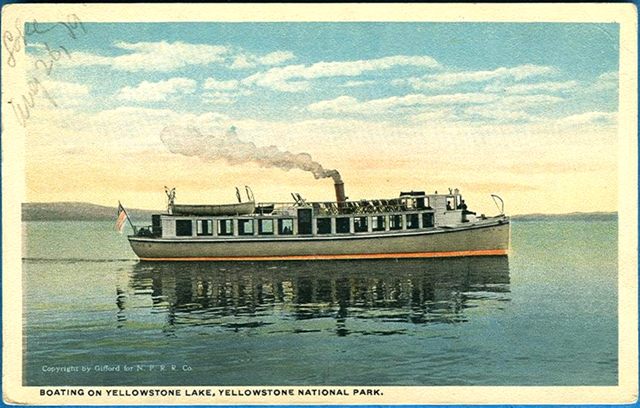
Boating On Yellowstone Lake (The Jean D)
Northern Pacific RR Co. Postcard
|
|
The Loop at Sylvan Pass, Cody Road to Yellowstone Park. H.H. Tammen #1698
|
The Fountain Hotel - Haynes No. 115
Printed Germany, ca1910
|
Concrete Bridge and Rapids
H.H. Tammen Co. #8127, ca1908
|
Interior H.E. Klamer's Curio Store
Detroit Publishing Co. #12541
|
Northern Pacific Railway Station and Entrance Arch, Gardiner Montana to Yellowstone
J.L. Robbins #1323, ca1930
|
Old Faithful Geyser in Winter
HAYNES-PHOTO No 198
Printed Germany, ca1908
|
The Haynes Family Postcards . . .
The most prolific of these publishers was the Haynes family and their chain of photo shops that were located throughout the park. Frank Jay Haynes began his Yellowstone photography business in Yellowstone in 1884 when he received leases from the government for photo shops at Mammoth Hot Springs and Old Faithful. He was at that time Official Photographer for the Northern Pacific RR. The Yellowstone Park Improvement Company, who ran the National Hotel at Mammoth and tent camps at other locations, appointed Haynes their Official Park Photographer – a position he and his son Jack retained (at least unofficially) for over 80 years. The Haynes family also retained a monopoly on Yellowstone photographs and souvenirs printed with Yellowstone images for many years. They produced Yellowstone postcards from 1900 until around 1967 when Isabel Haynes, the widow of Jack Haynes sold their 13 picture shops to the Hamilton Stores.
Prior to WWI Louis Glaser of Leipzig Germany was the primary publisher for Haynes Postcards. After that time the Curt Teich Co. took over most of the printing business. The Teich Co.of Chicago operated from 1898 to 1978 and was the world's largest printer of view and advertising postcards. The company was founded by Curt Otto Teich, who immigrated to the United States from Lobenstein, Germany in 1896. Teich was also the contract printer for the Yellowstone postcards of the Bloom Bros. Co., Sanborn Souvenir Co. and probably others.
The basic style of the Haynes postcards changed over the years and below is a sampling of cards that featured many of the styles and formats. There are of course, many varieties within any series, and a number of smaller series not posted here, and it is not my intent to try to list all of those varieties. The dates listed are a range for the listed series in general, and not the specific postcard. Thanks to the 2nd Edition of the Yellowstone Postcard Checklist, by Michael Francis & Kathie Burke for the date information.
(Visit my Haynes Photo Shop page for additional information on the operation.) Postcards from the author's collection.
|

Golden Gate, Vignette Series
1902-07, Undiv. Back
|
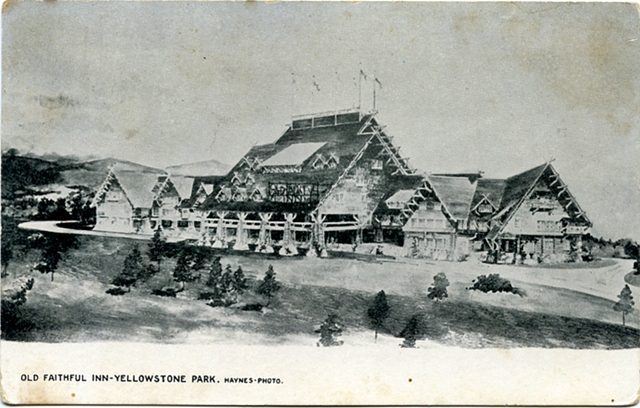
Old Faithful Inn
Black & White Series 1904-05, Wide Margin, Undiv. Back
|
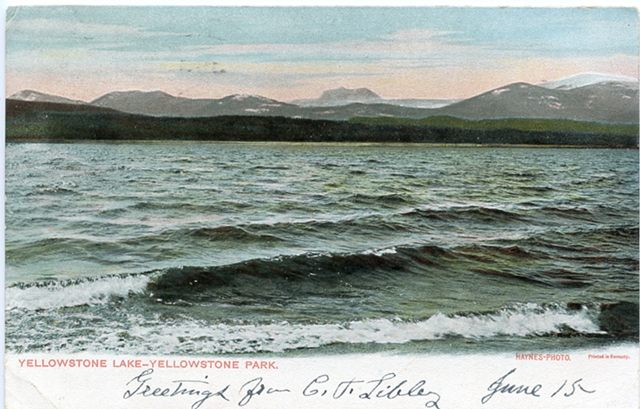
Yellowstone Lake
Autochrom Series 1904-06, Wide Margin, Undiv. Back, Germany |
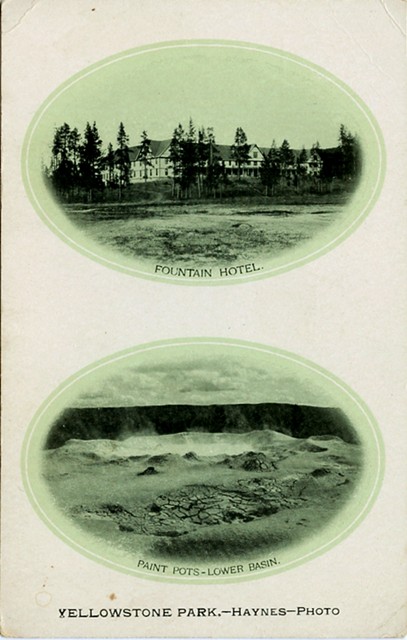
|
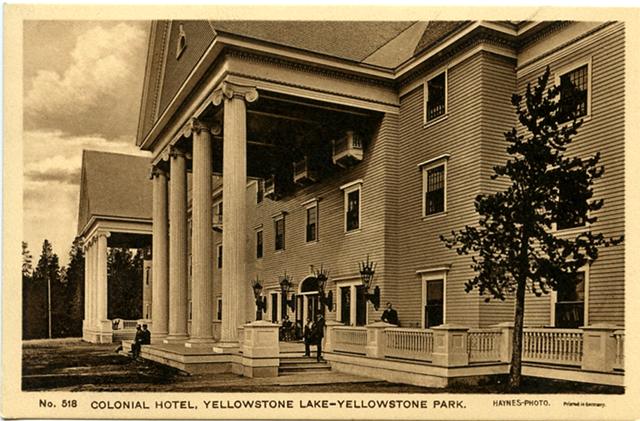
Left: Double Oval Series - 1907
Undiv. Back
Above: No. 518 Colonial Hotel
500 Series - 1914
Undiv. Back, Germany |
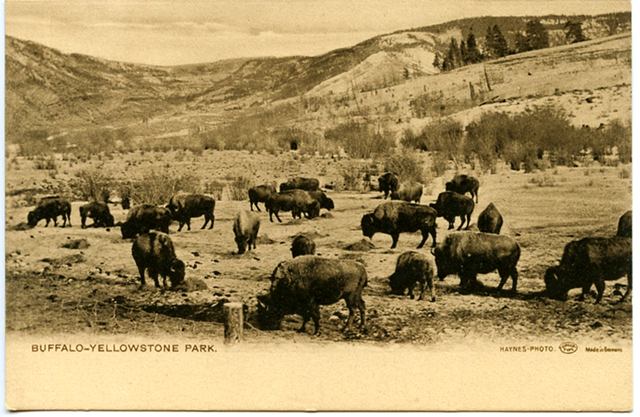
Buffalo - Sepia Series - ca1907
Wide Margin, Undiv. Back, Germany
|
|
No. 144 - Canyon Hotel
100 Series, ca1908-1916
Made in Germany prior to WWI
|
No. 208 - Thumb Lunch Station
200 Series, 1912-16, Germany prior to WWI
|
23475 The Lookout, Summit of Mt. Washburn, 10,317 FT
Red Letter 10,000 Series, ca1916-34
|
|
28029 Old Faithful Lodge
Black Letter Linen Series, ca1935-50
|
26357 Fountain Paint Pots (on reverse)
Real Photo Post Card (RPPC), ca1911-50s
|
Canyon Lodge Cafeteria (post-1957)
Photochrome Series, ca1951-67
|
For an illustrated Postcard listing of a variety of other
Yellowstone Post Card Publishers,
Please visit Page Two of this Chapter |
To view an explanation of the various postcard style eras from 1893 to the present, please check out an excerpt from
Jack & Susan Davis, "A Guide to Collecting Postcards."
A very concise and well-written explanantion and dating of the Pioneer Era, Private Mailing Card Era, Divided & Undivided Backs Era, Linen Era, Real-Photo Era, and Photochrome Eras. |
|
Selection of Varieties of Yellowstone Postcards:
Gruss Aus
This term is a literal translation from German for “Greetings from.” The cards typically have a set of vignette photos with the script announcing "Greetings from . . ." some particular town or scenic area. The earliest known Yellowstone picture postcard used this format. [1898 Edw. H. Mitchell]
|
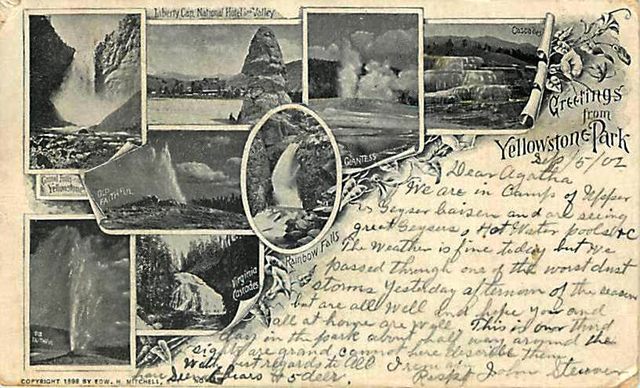 |
|
Vignette
Usually found on undivided back cards, consisting of a design that does not occupy the whole of the picture side. Vignettes may be anything from a small sketch in one corner of the card, to a design cover three quarters of the card. The purpose is to leave some space for the message to be written, as the entire reverse of the card could only be used for the address.
[353 Old Faithful Geyser, Div. Back ca1907, Embossed, Publ.??]
|
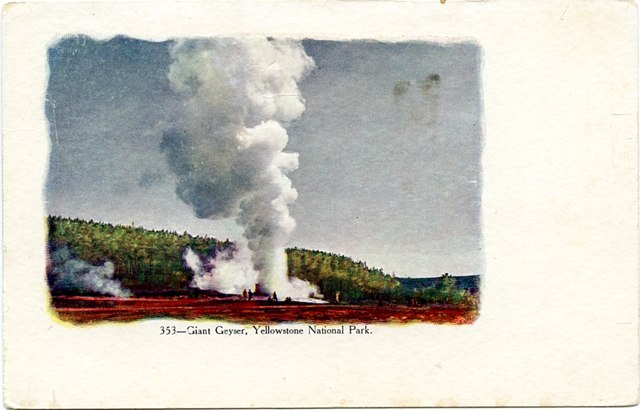 |
|
Embossed
Postcards with a raised surface. Postcards that have designs slightly raised above the card's surface. Heavily embossed postcards have almost a paper-mache style that stands greatly above the paper's surface.
[Illustrated Post Card Co, ca1908. Note beaded oval and filigree corners]
|
|
|
Real Photo Postcards (RPPC)
In 1903 Kodak introduced the No. 3A Folding Pocket Kodak. The camera, designed for postcard-size film, allowed photographs to be printed on postcard backs. In 1907 Kodak pioneered a service for the general public, ‘Real Photo Postcards.’ This service allowed the public to create a postcard from any photo they took. They are usually the same size as standard vintage postcards (3-1/2" x 5-1/2") and are also known by the acronym "RPPC". Kodak's 3A camera pioneered in its use of postcard-size film but was not the only one to make Real Photo postcards. Many other cameras were used, some of which used old-fashioned glass plates that required cropping the image to fit the postcard format. These cards can be an important historical resource as they may feature scenes not normally captured by commercial cards, such as views of the early hotels, camps, buildings, stagecoaches, boats. They typically are not retouched, which can be an occasional problem with commercial cards.
[Park Street, Gardiner, Mont., ca1940s]
|
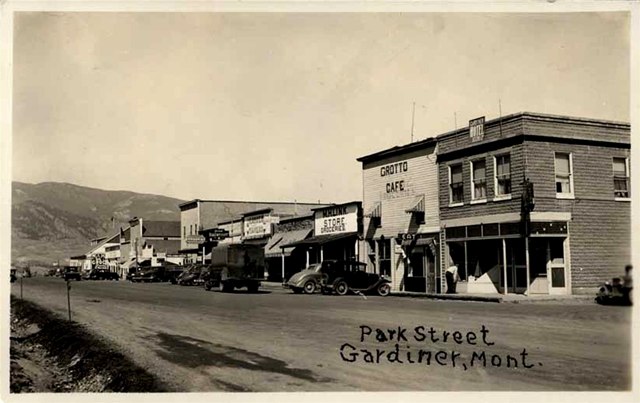 |
|
Sepia
Sepia toning is specialized photographic process designed to produce images that have a tint of light-to-medium brown in them. When they are produced in a traditional darkroom, this process would not only change the appearance of the final print, but would also extend its archival qualities as a result of the chemicals used in the process. A black & white print is used for the process. There are a number of different ways a sepia print can be created, and the intensity of the coloration can also be varied to suit the individual's personal preference. Sepia toning can also give a photograph an 'antique' look.
[No. 518 Colonial Hotel, Yellowstone Lake, Haynes Photo, Germany, ca1907
|
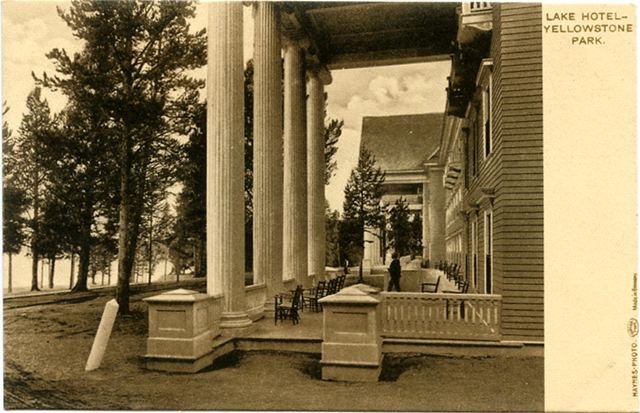 |
|
Linen postcards
These cards were produced in great quantity from 1931 to 1959. Contrary to the name, linen postcards are not produced on a linen fabric. But thanks to newer printing processes they were produced on an inexpensive card stock with high rag content, and then finished with a pattern which resembled linen. The face of the cards is distinguished by a textured cloth appearance which makes them easily recognizable. The reverse of the card is smooth as in earlier postcards. The rag content in the card stock allowed for a much more colorful and vibrant image to be printed than the earlier “white border” style. Due to the inexpensive production and bright realistic images they soon became quite popular.
[36430 - Canyon Hotel, Cocktail Lounge, Haynes Studios, ca1936]
|
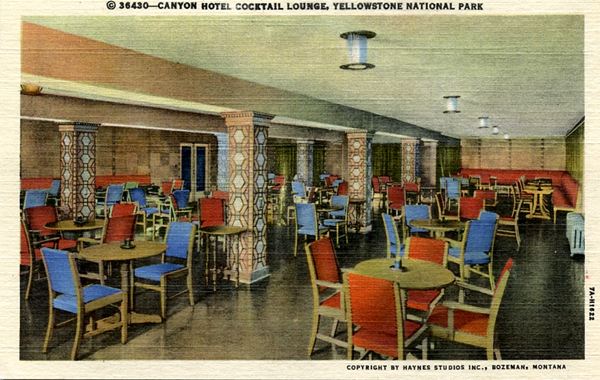 |
|
Chrome Cards
Around 1939 a new era of postcards began which has become known as the Chrome or Photchrom era. Production of the postcards slowed during World War II because of supply shortages, but after the war, they dominated the postcard market. The images on these cards are generally based on colored photographs, and are readily identified by the glossy appearance given by the paper's coating. The photochrom images closely resemble photographs and are the postcards most familiar to us today.
[53K353 Mammoth Springs Hotel Lounge, Haynes Studios, ca1950s]
|
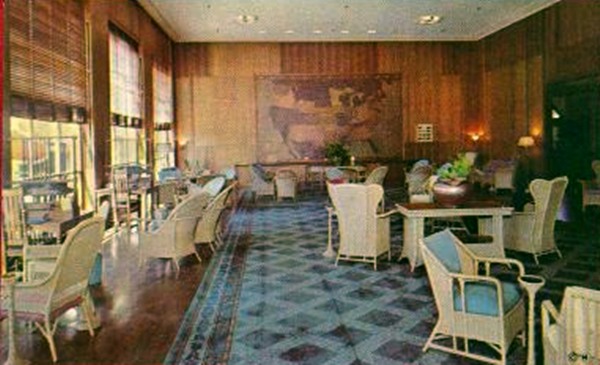
|
|
Novelty Cards
Any postcard created with features beyond a standard size or containing a simple picture can be considered a novelty card. Many novelties were printed on unusual substances such as wood, copper or leather, and were sometimes die cut into strange shapes or puzzles. Metallic powders, silk embroidery, coins, feathers, hair, and many other items were often added to them. Many have moveable parts and some actually make sounds. These cards were usually mailed in envelopes for protection of both the card and the mail handler. Many forms of novelties have their origins in the 19th century when they were produced as advertising for products or businesses and just for simple amusement.
[Telegraph Card, Publ.??, ca1908, David Hauptman was
the town Druggist in Gardiner, MT.]
|
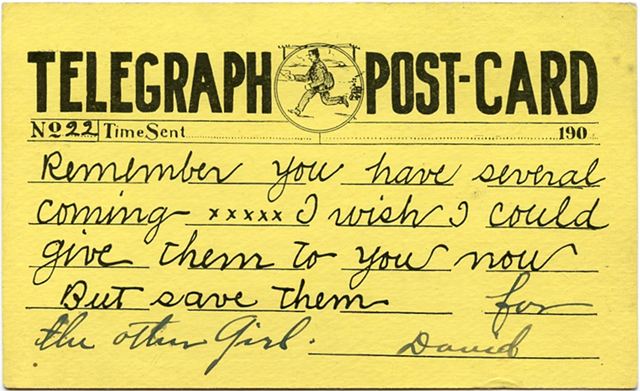
|
|
Foldout
A foldout, sometimes called a souvenir postcard folder, is a type of postcard printed on paper at least twice the length of standard size, and then folded into panels so it can be mailed as a regular sized postcard. The Haynes Co. had a set available as early as 1907. Two and three panels were common sizes, but some folders had as many as eight panels, sometimes double sided. With excessive wear these folds often tear apart and single panels can find their way into the market. They are often discernible by having only one or two ragged edges and possibly no labeling on them.
[Haynes Souvenir Folders, Series B & C, ca1930-40]
|
|
|
A Brief Chronology of United States Postal Cards
Most information courtesy of the Metropolitan Post Card Club web page.
1847 The United States issues its first postage stamp.
1848-1860 The first known postcard in the US is mailed. There are no official regulations regarding cards and they are treated as letters.
1861 Congress allows privately printed cards under one-ounce to be sent through the mail. Postage rates vary by distance. John P. Charlton copyrights the first postcard but none are known to be sent.
1873-1897 The US issued its first official Postal Card. One side was reserved exclusively for the address, the other for a message, and it cost a penny to mail regardless of distance. Privately printed cards were still allowed but they required two cents postage if they carried anything but advertising. This was the same as the letter rate, making these cards unpopular.
1893 Exposition Cards are issued on a large scale for the first time at Chicago’s Columbian Exposition. Their success prompts many others to begin publishing cards.
1893-1897 An economic depression hits the US forcing many printers out of business. Most cards are imported from Europe instead where a postcard craze has begun.
1897 The first postal card with Yellowstone images is published by Albert Kayser. The images were those of F. Jay Haynes in the Gruss Aus format.
1898-1901 Congress authorizes the use of the Private Mailing Card. It reduces the postage rate for all messages to a penny, but it had many size, color, and printing requirements. These restrictions forced many publishers out of the market, but the lower rates made these cards very popular and many others began to publish them.
1898 Edward H, Mitchell republishes Kayser’s card under his name. Also that year W.W. Wylie of the Wylie Camping Co. produced an advertising card overprinted on a government postal card with a view of the Gardiner River near Eagle’s Nest.
1899 The first Real Photo Postcard is sent through the US mail. The Detroit Photographic Co. publishes a set of ten postcards utilizing his own images in Vignette format.
1899-1900 The E.C. Kropp Co. publishes a pair of vignette PMCs depicting the Grand Canyon of Yellowstone and Castle geyser.
1900 In 1900 Frank J. Haynes issues a set of ten Private Mailing Cards that feature his photos.
1901 New regulations ended many of the restrictions required by Private Mailing Cards. In its place the privately printed Post Card was authorized.The images on postcards tended to become larger with only a small writing tab left to provided for a message. The first photo paper with a preprinted postcard back is put on the market enabling real photo postcards to be easily made.
1907 The US issues its first Divided Back Postcard. This allows for the address and message to be placed on the same side of a card, leaving the other side entirely available for an image.
1909 Congress authorizes tariffs on imported postcards at the bequest of American printers. Since most cards sold in the U.S. were manufactured in Germany, many jobbers stocked up on as many cards as they could before the tariff went into effect. This produced a glut of cards depressing prices.
1912 As tariffs effectively cut off the supply of most postcards from Germany, American printers failed to match their quality and quantity and demand quickly diminished. As postcards were dumped on the market, prices fell to an all time low forcing 25 percent of publishers out of business.
1914-1918 The First World War restricts the use of materials for postcards, curtailing production in Europe and further limiting imports to the United States. Many printers close due to shortages or war damage. The war also creates a worldwide shortage of printing ink as most is manufactured in Germany.
1925-1928 The postage for postcards is raised to two cents. It dramatically cuts down on their use but is repealed due to its unpopularity.
1931 Curt Teich begins printing postcards on Linen textured stock allowing cards to be printed with brighter dye based inks on high speed presses. Many other publishers follow his lead.
1938 Kodachrome, the first practical color transparency film was refined from the version first released two years earlier. Color separation can now be easily made to reproduce natural color and modern Photochrome (Chrome) cards begin to be published a year later.
1952 The Penny Postcard reaches its end as the mailing rate was raised to two cents once again. Only this time the price would continually go up.
1956 Photochromes, which had steadily grown in number in the post war years, completely replace linen postcards by this time to become the dominant format. Postcards would now be produced by offset lithography wholly by mechanical means.
|
Continue on to Page Two of this Chapter . . .
|
Suggested Sources For Further Research:
Yellowstone: A Guide to the Early Twentieth Century Postcards of F. Jay Haynes,
By Michael Bodell
The Detroit Publishing Company Postcards,
By Nancy Stechschulte
Yellowstone Postcard Checklist, 1897-1951 (2 editions)
By Mike Francis & Kathie Burke
Glimpses of Wonderland: The Haynes and Their Postcards of Yellowstone National Park,
By Richard L. Saunders
The Yellowstone Postcard Exchange (TYPE), 1996-2001
Published by J. Michael Bodell
|
Copyright 2014 by Robert V. Goss. All rights reserved.
No part of this work may be reproduced or utilized in any form
by any means, electronic or mechanical, including photocopying,
recording or by an information storage and retrieval system
without permission in writing from the author.
Yellowstone Trade Cards, also known as Advertising cards, are a fascinating novelty for the Yellowstone collector and enthusiast. They pre-date the postcard era and present a beautiful collection of artwork. In its original sense, the "trade" in trade card referred to its use by the proprietor of a business to announce his trade, or line of business. Later on, as emphasis shifted to the exchange or trade of cards by enthusiasts and collectors, the phrase “trade cards” evolved into "trading cards." By the 1880s, trade cards had become a major method of advertising business products and services. Some of the products most heavily advertised by trade cards were medicine, food, coffee, tea, tobacco, clothing, household goods, sewing notions, stoves, and farm equipment. Slightly smaller than postcards (3"x5"), the cards were originally handed out by grocers and storekeepers, but by the mid-1880's, many companies began to include advertising cards, or "trade cards" inside the packaging of their product in order to tout the virtue of their merchandise.
|
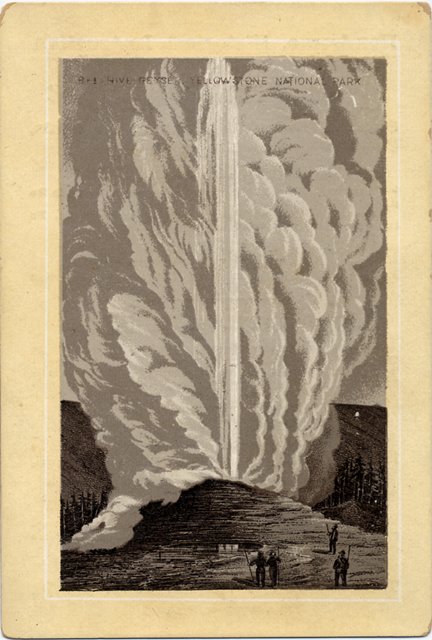 |
|